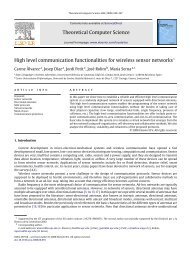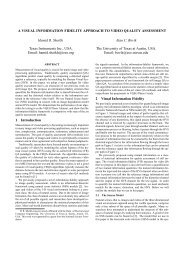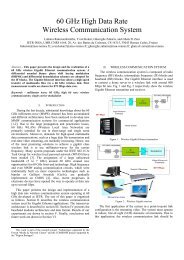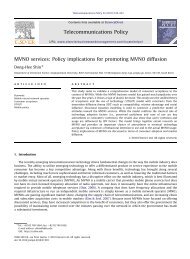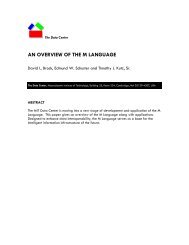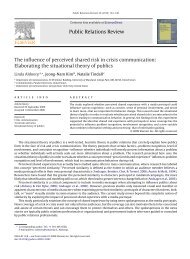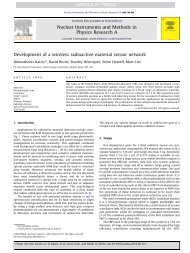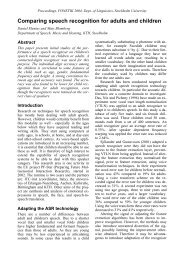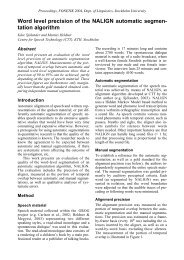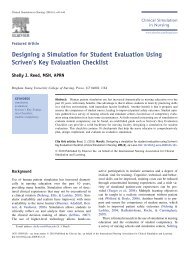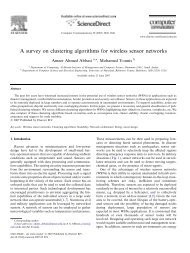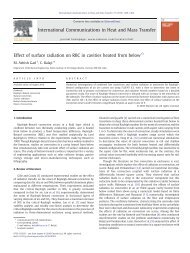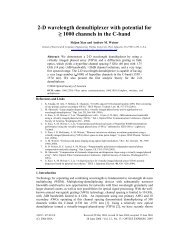BLR: beacon-less routing algorithm for mobile ad hoc networks
BLR: beacon-less routing algorithm for mobile ad hoc networks
BLR: beacon-less routing algorithm for mobile ad hoc networks
You also want an ePaper? Increase the reach of your titles
YUMPU automatically turns print PDFs into web optimized ePapers that Google loves.
3.2.1. Forwarding areas<br />
Forwarding areas are relative to the relaying node and<br />
may be basically of any shape provided that all nodes within<br />
the area are within each others transmission range. (This<br />
requirement may be dropped in cases where packet<br />
duplication is desired to increase redundancy and resilience.)<br />
An infinite number of areas fulfill this requirement.<br />
However, the <strong>for</strong>warding area should be large in order to<br />
increase the probability of finding a node within the area.<br />
Furthermore, another objective of the area is to favor nodes<br />
that are located near the border of the transmission range,<br />
which enables large progress per transmission and thus<br />
reduces the number of hops to the destination.<br />
In Fig. 2, three possible areas are depicted, namely a<br />
sector, a Reuleaux triangle and a circle, which all fulfill the<br />
condition of mutual possible reception <strong>for</strong> nodes located<br />
within these areas. For the sector and the Reuleaux triangle,<br />
this is achieved by an apex angle of 608, which limits the<br />
distance of two arbitrarily placed nodes to the transmission<br />
range r: The circle just has a diameter of r: The numbers in<br />
Fig. 2 indicate the ratio covered with the corresponding<br />
<strong>for</strong>warding area to the overall transmission area. We will see<br />
in Section 4 that this value and as well as the shape of the<br />
area have a strong impact on the behavior of the <strong>algorithm</strong>.<br />
3.2.2. Delay functions<br />
The function that computes DFD timer values of<br />
individual nodes may apply different <strong>for</strong>warding policies.<br />
Each node within the <strong>for</strong>warding area first determines<br />
different parameters, such as its progress p towards the<br />
destination with respect to the last hop and its distance<br />
d from the line S–D (cf. Fig. 1). From these values the<br />
node derives the DFD value Add_delay in the interval<br />
[0, Max_delay ].<br />
Three different delay functions are described below. The<br />
function in Eq. (1) implements basically MFR [25]. A node<br />
with <strong>less</strong> progress introduces a larger delay than a node with<br />
more progress. Consequently, the node with the most<br />
progress within the <strong>for</strong>warding area <strong>for</strong>wards the packet at<br />
M. Heissenbüttel et al. / Computer Communications 27 (2004) 1076–1086 1079<br />
first in order to minimize the number of hops to the<br />
destination.<br />
Add_delay ¼ Max_delay<br />
r 2 p<br />
r<br />
Add_delay ¼ Max_delay p<br />
r<br />
Add_delay ¼ Max_delay<br />
ffiffiffiffiffiffiffiffiffi<br />
e p2 þ d2 p !<br />
e<br />
The function in Eq. (2) implements a slightly modified<br />
NFP [26]. NFP is not directly applicable since a node does<br />
not know which neighbor is the nearest. The node with the<br />
least progress introduces the shortest delay and <strong>for</strong>wards the<br />
packet. The objective is to reduce energy consumption and<br />
increase the number of possible simultaneous transmissions<br />
which increases the overall capacity of the network as<br />
shown in Ref. [26].<br />
Inste<strong>ad</strong> of these basic functions, more <strong>ad</strong>vanced DFD<br />
functions are possible that not only take into account the<br />
progress of a node but as well the distance to the previous<br />
node. If progress is used as the only parameter, nodes<br />
located far away from the direct line S 2 D to the<br />
destination may be favored over a node with only little<br />
<strong>less</strong> progress but in almost straight direction towards the<br />
destination. Furthermore, it was shown in Ref. [42] that<br />
exponentially distributed random timers can further reduce<br />
the number of responses compared to uni<strong>for</strong>mly distributed<br />
timers. In Eq. (3), these observations are combined to a<br />
more <strong>ad</strong>vanced DFD function.<br />
In Fig. 3, the <strong>ad</strong>ditional delay introduced by Eq. (3) <strong>for</strong><br />
all nodes with <strong>for</strong>ward progress is depicted. Nodes close to<br />
the previous node introduce a short delay, whereas nodes<br />
located farther away compute a higher DFD timer.<br />
3.3. Unicast packets<br />
Bro<strong>ad</strong>casting of all data packets has several drawbacks.<br />
First, bro<strong>ad</strong>cast packets need to be passed to the protocol<br />
stack at each receiving node and cannot be dropped at the<br />
network interface card. Furthermore, data packets are<br />
Fig. 2. Different <strong>for</strong>warding areas. Fig. 3. Additional delay vs. progress vs. distance.<br />
ð1Þ<br />
ð2Þ<br />
ð3Þ


